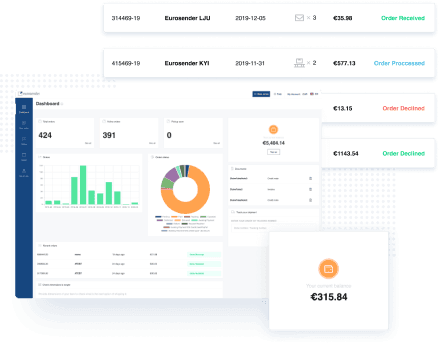Cost-effective animal forage delivery by courier
Whether you need to find the optimal bulk cattle and poultry feed transportation service or simply want to send hay for small animals to your clients, with Eurosender, you will get the best rates on the market. We provide optimal shipping solutions for animal feed importers, manufacturers, resellers, and individual clients within a few seconds. Check our tips on how to pack such products for transport and book fast and reliable animal forage delivery by courier through our easy-to-use shipping platform.
ARE YOU A BUSINESS?
Bulk cattle and poultry feed transportation services for companies
If you are a licensed manufacturer or retailer of livestock feed for cattle, poultry, or horses, join thousands of businesses that have chosen Eurosender as their permanent shipping platform and optimise your logistics processes. Save on every shipment and have all relevant delivery information in one place.

HOW TO SHIP?
Send animal feed nationally and internationally with Eurosender
Eurosender can offer multiple options for shipping animal forage across the country and abroad to accommodate all your shipping needs.

Standard shipping
A cost-effective choice for shipping small parcels with animal forage abroad or across the country
Learn more

Pallet delivery
The most suitable bulk cattle and poultry feed transportation option for importers and exporters
Learn more

Van delivery
Transportation service across Europe dedicated solely to you, same-day pickup, no stopovers
Learn more

Individual offer
Get a customised solution tailored to your shipping requirements in less than 2 hours
Learn more
HOW TO PACK?
How to pack animal forage for shipping?
Here are the steps to follow for packing and shipping animal forage abroad or across the country:
- If the hay for rabbits, livestock feed, chicken feed, horse feed, or compound animal feed does not have any packaging, place it in a plastic or a woven bag.
- Cover each bag with foam wrap to create an additional layer of protection.
- Take a cardboard box and fill the bottom with cushioning materials (packing peanuts, crumpled paper, etc.).
- Put the bags inside the box.
- Fill empty spaces with more cushioning materials.
- Close the box and seal it with adhesive tape.
- Prepare a pallet for large animal forage shipments.
- Stack the bags or boxes one onto another.
- Fix them with straps.
Animal feed import regulations
Animal feed must comply with the competent food safety authority requirements of the destination country. If you are planning to send animal feed internationally to the US, these products must comply with the FDA requirements, while in the EU, these goods are regulated by EFSA. In the UK, animal feed legislation is carried out by the FSA.
MORE INFORMATION
FAQs on shipping animal forage domestically and abroad
How to organise livestock feed delivery to clients? Can Eurosender help me?
Through the Eurosender shipping platform, you will find the most suitable option for bulk cattle and poultry feed transportation to your clients in just a few clicks. We help SMEs to focus on growing their businesses by simplifying all their logistics processes. One account gives you access to a network of multiple national and international carriers. With our smart algorithm, you always get a pre-negotiated price for any shipping service. Register an account and organise door-to-door animal forage delivery by courier to any address in a few clicks with Eurosender!
What is the fastest Eurosender service for livestock feed delivery in bulk?
At Eurosender, we recommend opting for van delivery as the fastest transportation method for large and heavy shipments across Europe. With this service, your animal feed supplies will be picked up on the same day and transported directly to the destination point, which significantly reduces transit time.
How to import animal feed?
Make sure that the products you intend to import comply with existing regulations in the pickup and the delivery country. Be ready to provide all the necessary documentation for the customs clearance procedure. If you have any specific questions regarding the most cost-effective bulk cattle and poultry feed transportation method, do not hesitate to contact our logistics experts. They will gladly assist you.
Is there any insurance for shipping cat and dog supplies by courier?
Food is on most courier companies’ restricted items list. If it is sent by individuals, in most cases, the insurance will not apply, but proper packaging will minimise the risks. Licensed companies sending animal feed nationally or internationally via freight transport services have CMR insurance coverage.